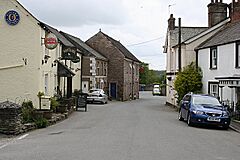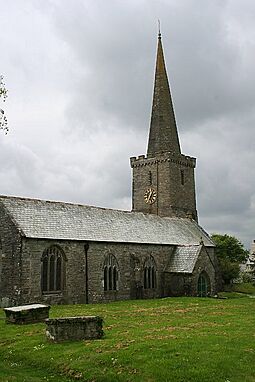Menheniot facts for kids
Quick facts for kids Menheniot
|
|
|---|---|
 Menheniot village |
|
| Lua error in Module:Location_map at line 530: Unable to find the specified location map definition: "Module:Location map/data/Cornwall (mainland)" does not exist. | |
| Population | 1,716 (United Kingdom Census 2011 including Doddycross) |
| OS grid reference | SX289628 |
| Civil parish |
|
| Unitary authority | |
| Ceremonial county | |
| Region | |
| Country | England |
| Sovereign state | United Kingdom |
| Post town | LISKEARD |
| Postcode district | PL14 |
| Dialling code | 01579 |
| Police | Devon and Cornwall |
| Fire | Cornwall |
| Ambulance | South Western |
| EU Parliament | South West England |
| UK Parliament |
|
Menheniot (say it like Men-en-yut) is a village and civil parish in Cornwall, England. It is about 2.5 miles (4 km) southeast of Liskeard. The name "Menheniot" means "sanctuary of Neot," which comes from old Cornish words.
In 2011, about 1,655 people lived in Menheniot. The village has a primary school, a pub, a shop, and a post office. It's a small, friendly place with a lot of history.
Contents
Exploring Menheniot's Nature
Menheniot is home to some interesting natural spots.
Clicker Tor Quarry
South of the village, you'll find Clicker Tor Quarry. This area is a Site of Special Scientific Interest. This means it's a very important place for nature and science. It has some of the best examples of special rocks called ultramafic rocks in South West England. These rocks are very old and tell us a lot about the Earth's past.
Other Local Spots
- At Coldrenick, there was a black and white mansion built in 1870.
- In Merrymeet, there is a small church called St Mary the Virgin.
Menheniot Parish Church
The main church in Menheniot village is dedicated to St Lalluwy. It's a beautiful old building from the 1300s. The church has a tall tower with a spire pointing to the sky.
Church History
The church has been changed and fixed up many times over the years. In 1478, the church became connected to Exeter College, Oxford. This meant the college helped manage the church. In the Middle Ages, there were five smaller chapels in the parish, but they were closed down later.
Many important people have been in charge of the church, including William Wykeham in 1365. Another notable person was John Moreman, who worked there from 1529 to 1554. He was the first to teach people the Lord's Prayer and other important lessons in English.
Inside the Church
Inside the church, you can see some cool features:
- The ceilings are made of wood and look like wagon roofs.
- The pulpit, where the priest gives sermons, was made in 1891. It shows pictures of polar adventures!
- There's a very old metal plate called a monumental brass. It remembers Sir Ralph Carmynow, who died in 1386. This is the oldest one in all of Cornwall.
- You can also find monuments to the Trelawny family, who were important local figures.
Famous Burials
Captain John Richards Lapenotière is buried in the churchyard. He lived in the parish until he died in 1834. He was famous for being the first person to bring the news of the great Battle of Trafalgar back to London.
Menheniot's Economy and Travel
Menheniot used to be a busy place for mining.
Mining History
In the 1840s, people found lead in the ground around Menheniot. This started a big mining boom that lasted until the 1870s. During this time, the number of people living in the village doubled! One important mine was Wheal Trelawney, which dug for lead and arsenic. It operated from 1840 to 1890.
Train Station
Today, Menheniot has its own train station, called Menheniot railway station. It's on the Cornish Main Line, which is a major railway route. You can catch a train here with Great Western Railway.
Cornish Wrestling
In the 1800s, Menheniot was a place where Cornish wrestling tournaments were held. People would compete for prizes in this traditional sport.
See also
 In Spanish: Menheniot para niños
In Spanish: Menheniot para niños


